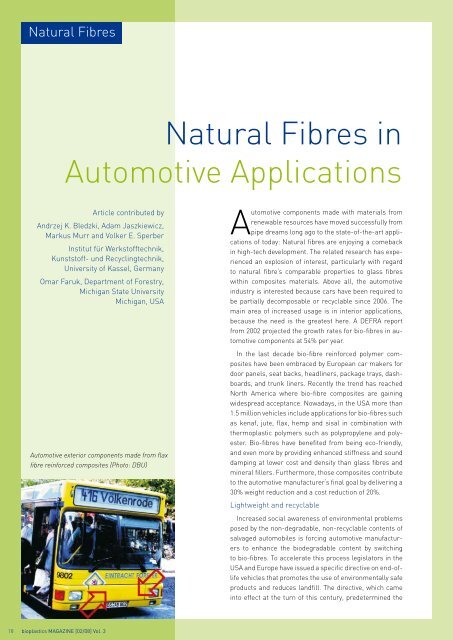02 | 2008
Create successful ePaper yourself
Turn your PDF publications into a flip-book with our unique Google optimized e-Paper software.
Natural Fibres<br />
Natural Fibres in<br />
Automotive Applications<br />
Article contributed by<br />
Andrzej K. Bledzki, Adam Jaszkiewicz,<br />
Markus Murr and Volker E. Sperber<br />
Institut für Werkstofftechnik,<br />
Kunststoff- und Recyclingtechnik,<br />
University of Kassel, Germany<br />
Omar Faruk, Department of Forestry,<br />
Michigan State University<br />
Michigan, USA<br />
Automotive exterior components made from flax<br />
fibre reinforced composites (Photo: DBU)<br />
Automotive components made with materials from<br />
renewable resources have moved successfully from<br />
pipe dreams long ago to the state-of-the-art applications<br />
of today: Natural fibres are enjoying a comeback<br />
in high-tech development. The related research has experienced<br />
an explosion of interest, particularly with regard<br />
to natural fibre‘s comparable properties to glass fibres<br />
within composites materials. Above all, the automotive<br />
industry is interested because cars have been required to<br />
be partially decomposable or recyclable since 2006. The<br />
main area of increased usage is in interior applications,<br />
because the need is the greatest here. A DEFRA report<br />
from 20<strong>02</strong> projected the growth rates for bio-fibres in automotive<br />
components at 54% per year.<br />
In the last decade bio-fibre reinforced polymer composites<br />
have been embraced by European car makers for<br />
door panels, seat backs, headliners, package trays, dashboards,<br />
and trunk liners. Recently the trend has reached<br />
North America where bio-fibre composites are gaining<br />
widespread acceptance. Nowadays, in the USA more than<br />
1.5 million vehicles include applications for bio-fibres such<br />
as kenaf, jute, flax, hemp and sisal in combination with<br />
thermoplastic polymers such as polypropylene and polyester.<br />
Bio-fibres have benefited from being eco-friendly,<br />
and even more by providing enhanced stiffness and sound<br />
damping at lower cost and density than glass fibres and<br />
mineral fillers. Furthermore, those composites contribute<br />
to the automotive manufacturer‘s final goal by delivering a<br />
30% weight reduction and a cost reduction of 20%.<br />
Lightweight and recyclable<br />
Increased social awareness of environmental problems<br />
posed by the non-degradable, non-recyclable contents of<br />
salvaged automobiles is forcing automotive manufacturers<br />
to enhance the biodegradable content by switching<br />
to bio-fibres. To accelerate this process legislators in the<br />
USA and Europe have issued a specific directive on end-oflife<br />
vehicles that promotes the use of environmentally safe<br />
products and reduces landfill. The directive, which came<br />
into effect at the turn of this century, predetermined the<br />
18 bioplastics MAGAZINE [<strong>02</strong>/08] Vol. 3


















